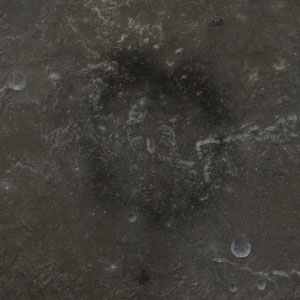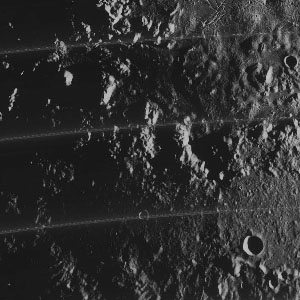Mare Pacificus
Contents
[hide]Mare Pacificus
(unofficial name; alternate name: Orientale dark mantle ring deposit, also unofficial)
| Lat: 30.1 S, Long: 97.3 W, Diameter: 175 km, Depth: km, Rukl: Libration Zone VII |


Left: Clementine multi-band mosaic from PDS Map-a-Planet remapped by LTVT, Right: Lunar Orbiter 4-187M photo remapped by LTVT
Images
LPOD Photo Gallery images Zond 3 discovery image
Frame 5, made by ZOND 8, shows Mare Pacificus at about "4 to 5 o'clock" of Earth. The large dark region at about "8 o'clock" of Earth is Mare Orientale. Research: Danny Caes
Maps
Description
A dark ring on the southern edge of the Orientale Basin. Thought to be a deposit of volcanic ash from an eruption from a small vent at its center.
Additional Information
- This currently unnamed feature was given the name Mare Pacificus by the Soviets who discovered it, presumably on Zond images. It was first drawn by J.H.G Franz in his 1906 book, Der Mond. [from Baum & Whitaker (2007) Discovery and nomenclature of the Mare Orientale. J Br. Astron. Assoc. 117, 3, p 129-135, note 17.]
-- Chuck Wood - The diameter in the title line is from Head, Wilson and Wietz (2002). The coordinates were measured with LTVT on the Clementine basemap. Head et al. give them as 29 S/ 263 E (= 97 W). They call this formation the Orientale dark mantle ring deposit.
- The two views at the top of the page show the same region as viewed by two instruments. The region of interest is just on the terminator in the Lunar Orbiter view. The 22 km diameter crater at the lower right of this view is Focas, while the 10 km one nearer to the center is Focas U. The linear valleys above center in the Lunar Orbiter view are officially known as Rimae Focas. They are just above a band of peaks which are part of Montes Rook. Those at the bottom of the image are in Montes Cordillera. Both of those ranges are rings of peaks around Mare Orientale, whose center is to the north (above the top of these images).
- The volcanic vent that Head et al. take to be the source of the ash can be seen as the small football-shaped gouge at the center of the Clementine image (in shadow in the Lunar Orbiter view). The mechanism by which the ash would be spewed in a ring is something akin to material flowing up the handle of an umbrella, and landing at the edges of its outstretched skirt.
- Jim Mosher
Nomenclature
The Maw (Ch.Wood's nickname for the curious gouge at the center of Mare Pacificus)
LPOD Articles
Mare Pacificus
The Maw (the football-shaped gouge at the center of Mare Pacificus)
The Kiss of Fire (colorful close up of The Maw)
Bibliography
- Shabanov, M. F. (1975) Digital and analog electronic methods for isophotometric analysis of astronomical photographs Soviet Astronomy, vol. 19, no. 2, p. 245-251. (mentioned at top of p. 247)
- Shevchenko, V. V. (1990) A Possible Lunar Science Objective for Galileo Abstracts of the Lunar and Planetary Science Conference, volume 21, page 1144, (1990) (describes initial interpretation as a mare falsified by Lunar Orbiter images of dark ash strewn over mountains)
- Coombs, Cassandra R.; Hawke, B. R. (1992) Pyroclastic deposits on the western limb of the moon IN: Proceedings of Lunar and Planetary Science, Volume 22; Conference, Houston, TX, Mar. 18-22, 1991 (A92-30851 12-91). Houston, TX, Lunar and Planetary Institute, p. 303-312. (extensive references on p. 306)
- Head, JW, L Wilson & CM Weitz (2002) Dark ring in southwestern Orientale basin: Origin as a single pyroclastic eruption. J. Geophys. Res. 107, E1, 5001. (detailed interpretation)